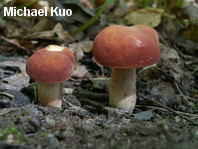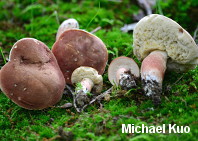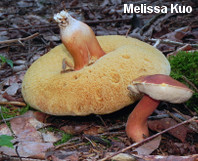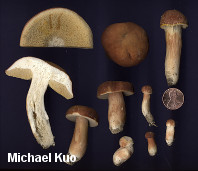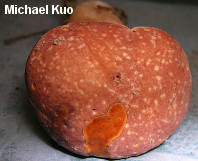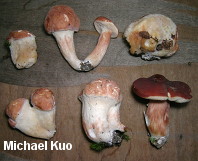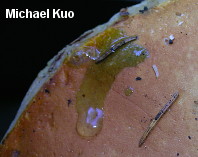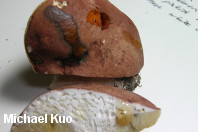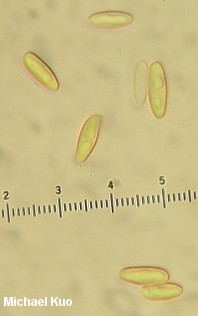| Major Groups > Boletes > Xanthoconium purpureum |

|
Xanthoconium purpureum [ Basidiomycota > Boletales > Boletaceae > Xanthoconium . . . ] by Michael Kuo Xanthoconium purpureum is one of the most common summer boletes in the oak-hickory forests of the Midwest, and it is also frequently reported in hardwood forests to the east. Its cap is purplish brown to reddish brown (or, occasionally, merely brown) and its pore surface changes from creamy white to, at maturity, a fairly bright brownish yellow, without any olive shades. In my experience it also develops a distinctive, somewhat foul and bad-meat-ish odor at just about the time the spores mature. For years I assumed that Xanthoconium purpureum was Xanthoconium affine, AKA Boletus affinus--a similar species, frequently featured in field guides. But Xanthoconium affine tends to be more brown and less purplish or reddish, and its cap surface (this is the clincher) does nothing interesting when a drop of ammonia is applied. Xanthoconium purpureum, however, demonstrates a magnificent flash of green with ammonia. But here's the thing. Almost nothing else separates Xanthoconium purpureum and Xanthoconium affine. The cap color and the ammonia reaction (which might easily be essentially the same thing, if the reddish pigment is what the ammonia is reacting to) are it. Even some of the eccentricities of Xanthoconium affine--the fact that its cap sometimes develops numerous whitish spots (which leads some authors to acknowledge Xanthoconium affine var. maculosus) and the fact that, as Smith & Thiers noted (1971), "the margin of the pileus [frequently] becomes intergrown with the stipe, reminding one of the condition frequently encountered in Gastroboletus"--are mirrored in Xanthoconium purpureum. There are several plausible explanations for these issues, ranging from the idea that a single, variable species may be involved to the proposition that Smith and Thiers included Xanthoconium purpureum in their concept of Boletus affinis (an idea supported by analysis of the timeline of their publications and the fact that they did not, even once, designate a collection as Xanthoconium purpureum, which they called "Boletus purpureofuscus"). Or both. A contemporary, DNA-informed study of these species, based on many well documented collections, is clearly needed. "Boletus purpureofuscus" is a synonym. Description: Ecology: Mycorrhizal with oaks; growing alone, scattered, or gregariously; early summer through fall; probably widely distributed east of the Great Plains. The illustrated and described collections are from Illinois and Pennsylvania. Cap: 4-13 cm across; convex to broadly convex in age; soft; dry; very minutely velvety when young, but soon bald; purplish red to maroon, reddish brown, or (less frequently) merely brown; occasionally developing numerous whitish to yellowish spots; usually fading to cinnamon or tan. Pore Surface: Creamy white at first, becoming bright brownish yellow and, eventually, yellowish brown (but never developing olive shades); not bruising, or bruising yellowish to brownish, especially when young; with 2-3 circular pores per mm; tubes 1-2 cm deep. Stem: 4-7 cm long; 1-3 cm thick; more or less equal, or tapered somewhat at the base; bald; pale at apex, but colored like the cap, or streaked with the cap color, below; often also streaked with yellowish and/or pinkish areas; not reticulate; basal mycelium white. Flesh: Whitish; unchanging when sliced. Odor and Taste: Taste not distinctive. Odor not distinctive at first, but often becoming foul (like bad meat) as the spores mature. Contorted Forms: Often encountered alongside normal forms; pore surface partially to completely fused with stem and cap margin; cap and stem becoming whitish and somewhat inflated; odor foul, like rotting meat. Chemical Reactions: Ammonia flashing dark green, then resolving to negative, with a blackish ring, or reddish, on cap surface; negative on flesh. KOH negative, red, or orangish on cap surface; negative on flesh. Iron salts negative on cap surface; negative on flesh. Spore Print: Bright yellow-brown. Microscopic Features: Spores 9-12 x 3-4 µ; narrowly fusiform; smooth; yellow in KOH. Hymenial cystidia lageniform; 35-50 x 7.5-10 µ. Pileipellis a tightly packed trichoderm with clavate, subclavate, or cystidioid terminal elements (an "epithelium" or hymeniform turf); hyaline to ochraceous in KOH. REFERENCES: Snell & Dick, 1961. (Snell & Dick, 1970; Smith, Smith & Weber, 1981 [B. purpureofuscus]; Both, 1993; Bessette, Roody & Bessette, 2000; Binion et al., 2009; Kuo & Methven, 2014.) Herb. Kuo 06019505, 06269505, 06130208, 06300705, 07010702, 07040703, 06031009, 07061405, 07211411. This site contains no information about the edibility or toxicity of mushrooms. |
© MushroomExpert.Com |
|
Cite this page as: Kuo, M. (2015, January). Xanthoconium purpureum. Retrieved from the MushroomExpert.Com Web site: http://www.mushroomexpert.com/xanthoconium_purpureum.html |
